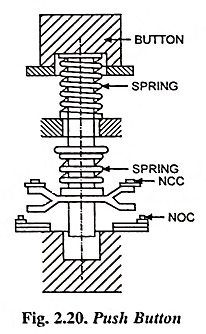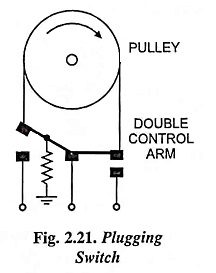Various Pilot Devices in Motor Control:
Motor control devices may be classified as primary control devices and pilot control devices. Pilot devices control the primary control devices which in turn controls (connects or disconnects) the motor or load. For example in D-O-L (direct-on-line) starter main contactors and tripple pole switch, which connect the motor to the line are classified as primary control devices where as start or stop push buttons which energizes or de-energizes the operating coil are called the pilot devices. Pilot devices usually have sensing element to sense temperature, liquid level, fluid pressure or mechanical pressure applied etc. Pilot devices convert what they sense into the control of primary control devices. The most important of pilot devices are push buttons, master switches, float switches, thermostats, pressure regulators, plugging switches, limit switches.
1. Push Button:
This is the most simple pilot device and provides control by pressing a button. The push-button switches are used in remotely operated electromagnetic apparatus and signaling circuits. Push buttons are usually of two types namely maintained contact type in which on pushing of the button the contacts close and remain closed until stop button is pushed and the momentary contact type in which contacts remain closed till push button is held pushed. The contacts of push buttons are usually double break, actuated by plastic buttons. Two sets of contacts are usually provided namely normally open contacts ‘NOC’ and normally closed contacts ‘NCC’. so that when the button is pressed one set is opened and the other set is closed. The push button station usually consists of a green button to start and red button to stop. Start push button is provided with normally open contact (NOC) and stop push button is provided with normally closed contact (NCC). The contacts are made silver tipped to withstand numerous of switching operations. Since push buttons are used in control circuits, not used in power circuits, current rating of push button station is, therefore, usually very small (2 A, 500 V for ac working). On pressing start push-button contactor coil is energized, which closes the main contactor in the circuit.
2. Limit Switches:
Limit switches are ordinarily used as pilot devices in control circuits of magnetic starters to govern starting, stopping, or reversing of electric motors. These may be used either as control devices for regular operation or as emergency switches to prevent improper functioning of machinery. These are actuated by the travel of the driven machinery and automatically disconnect the machine after it has travelled through its entire path. These switches can be actuated by cams, levers, push rods and the like, and also through gears. Lever type actuators may be either of normal roller type or angular type. The switch is either stationary and actuated by some moving member or it moves with the machine and is actuated by a stationary member. These are usually provided with one NOC (normally open contact) and one NCC (normally closed contact). These switches are usually air break type. These are also used for opening and closing of doors, cinema curtains, lifts and elevators etc.
3. Master Controllers:
A device or a group of devices that governs in a predetermined manner the supply of electric power to an electric apparatus with a view to accelerate, decelerate, start, stop or reverse it according to requirement is called the controller. The device performing the above functions in respect of many units at a time is called the master controller. Master controllers can employ different methods for closing or opening the contactors namely all-electric method, electropneumatic method and the camshaft method. In the all-electric method, the contactors are operated by solenoids and the drawback of this method is that supply variations may cause uncertainty of action of the contactors. In the electropneumatic method solenoids operate the valves that admit air into cylinders in which movable piston close or open the contactors and in the cam shaft method, the contactors are operated by cams mounted on a shaft driven by an electric or a pneumatic motor. In electropneumatic or in cam shaft method large mechanical forces can be put on the contactors, so that vibration can cause no harm : moreover the systems are electrically simple and mechanically very robust and are, therefore, favoured.
4. Transfer Switches:
Sometimes operation and control of an electrical equipment becomes necessary from either of two masters of pilot devices, such as control of multiple unit stock by two master controllers at the ends of a train. This is accomplished by making use of switches, called the transfer switches, which enable electrical apparatus to be connected to either of the masters. These are merely double throw switches having required number of poles.
5. Speed Governors:
These are employed for protection of rotating machinery against overspeed, under-speed or to perform some functions at a given speed of the machine. These are actuated by centrifugal force.
6. Float Switches:
This is a type of limit switch and is actuated by a float through a chain, one end of which is connected to the float and the other to the counterweight. Stops connected to the chain move a lever which turns and tilts the mercury tube forming a switch contact. These are designed and used for maintaining a certain level of liquid. The raising or lowering of a float mechanically attached to electrical contacts may start motor driven pump to empty or to fill tanks, whichever is desired. They are also used for opening or closing piping valves for the control of fluids.
7. Pressure Switches and Regulators:
The pressure switches and regulators are widely used in industry. These are designed to cover the wide range of requirements encountered in the control of pneumatic or hydraulic machines. These controls are most commonly used in the control circuits of welding equipment, high pressure lubricating system, machine tools and motor driven pumps and compressors. These are available in various pressure ranges. A diaphragm actuated device is designed for applications requiring sensitive response to small pressure changes at low pressure ranges. A seamless metal-bellows actuated control is used for pressures as high as 1.5 kg/mm2 and the piston operated hydraulic switches are used for pressures up to 10 kg/mm2.
Gauge type pressures regulators provide accurate control of pressure or vacuum conditions on the systems on which they are used. When used as pilot control devices with magnetic starters, they govern operation of pump or compressor motor similar to pressure switches. Reverse action regulators may also be employed on pressure system interlocks to prevent an operation until the pressure in that system has increased to the point desired.
Pressure regulators consist of a Bourdon type pressure gauge and control relay. Delicate contacts on the gauge energise the relay, causing it to be closed or opened, as the case may be. Thus the relay contacts are used to control a large motor starter, avoiding possible burning of the gauge contacts. Regulators for standard operation open the circuit at high pressure and close the circuit at low pressure. Special regulators operate on reverse operation to close the circuit at high pressure and to open the circuit at low pressure.
8. Thermostats:
The thermostat is a two or three (or more) wire control pilot device that is temperature actuated. Thermostats indirectly control large motors in air-conditioning systems and in many industrial applications.
General industrial temperature controllers are recommended for heating applications where the temperature to be controlled is higher than the normal or ambient temperature. In general, the application would be in connection with the controlled liquids rather than gases because of the relatively greater conductivity between bulb and liquid when compared to conductivity between bulb and gas. Generally, where air or gas temperature is to be controlled, the sensitivity will decrease and the difference between “on and off” will widen.
Gas vapour or liquid pressure expands a metal bellows against the force of a spring to give a motion to an operating pin, which snaps a precision switch to its operating position when the setting is reached. This is very similar to industrial pressure switches. The operating pressure is generated in proportion to the temperature of liquid in a closed bulb. The precision switch snap back to its normal position when the pressure in the bellows drops enough to allow the main spring to compress the bellows. Thermostats are of many different designs and are used in control circuits to operate heaters, blowers, fans, pumps, solenoid, valves and other devices.
9. Plugging Switches:
Plugging switches, also called zero-speed switches or speed relays, were primarily designed for incorporation into control circuits as pilot devices to provide quick automatic stopping of machines driven by squirrel cage motors. Properly adjusted plugging switches are capable of preventing reversal of rotation of the controlled drive after it has been brought to standstill by the reversal of motor connections. These are often used on machine tools that must come to sudden stop at some point in their cycle of operation to prevent inaccuracies in the work or damage to the machine. Another application is found in processes where the machine must come to a complete stop before the next step of work is started, here the reduced stopping time saves time for a greater total output.
The shaft of the plugging switch, is mechanically coupled to the motor shaft or to a suitable shaft on the driven machine. Motion of the motor or driven machine is transmitted to the switch contacts by a centifugal mechanism or a magnetic induction (eddy current disk) arrangement within the switch. The contacts are wired to the reversing starters which control the motor. Acting as a link between the motor and reversing starter, the switch allows the starter to apply just enough ‘reverse’ power to bring the motor to a quick stop.

